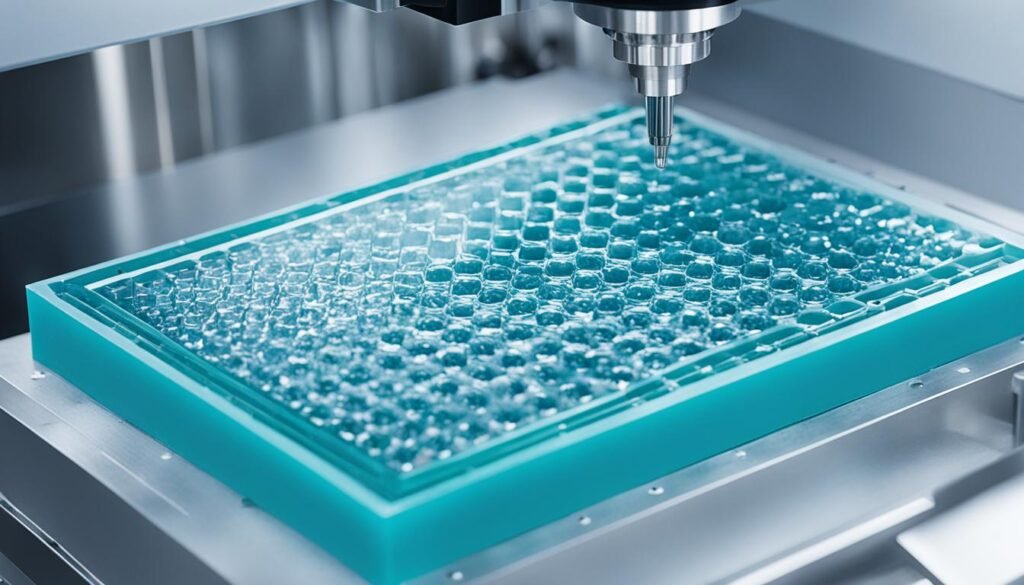Did you know that injection molding is key in making THY Precision Injection Molding Optical Lenses for medical imaging? The process seems simple, but making perfect optical parts for healthcare is complex. As medical imaging tech gets more advanced, knowing how to overcome challenges in Injection Molding Optical Lenses is vital.
THY Precision leads in making top-notch plastic parts, including injection molding optical lenses for medicine. We’ll look into the Injection Molding Optical Lenses process step by step. We’ll talk about the challenges in making optical lenses and how to solve them for the best quality and performance.
Key Takeaways
- Injection Molding Optical Lenses is a versatile and cost-effective way to make optical lenses for medicine.
- Knowing the details of the Injection Molding Optical Lenses process, from picking materials to designing molds, is key for quality optical parts.
- Picking the right materials and designing molds well is crucial to beat common issues in injection molding optical lenses.
- Improving the process and strict quality checks help make perfect optical lenses for medical imaging.
- THY Precision’s skill in Injection Molding Optical Lenses and deep knowledge of the medical field make them a reliable partner in precision optical parts.
UnderstandingInjection Molding Optical Lenses step by step
The Injection Molding Optical Lenses is key in making many plastic items, like medical devices and car parts. Knowing how injection molding works helps us understand its power. At THY Precision, we aim to make our clients fully grasp the injection molding process step by step.
The Injection Molding Cycle
The injection molding cycle is the series of steps in plastic injection molding. It includes several important steps:
- Mold Closing: The mold parts come together, and the mold design is set.
- Plasticization: The molding materials go into the hopper, get melted, and gather in front of the screw.
- Injection: The screw moves forward, pushing the melted plastic into the mold.
- Holding Pressure: The screw keeps a certain injection pressure to fill the mold fully and keep the part’s shape.
- Cooling: The mold cools, letting the plastic harden and take the mold’s shape.
- Ejection: The finished part comes out of the mold, and the cycle starts over.
Every step in the injection molding cycle is carefully managed for top-quality parts. THY Precision’s experts team up with our clients to fine-tune the melt temperature, cooling time, and other key factors for their injection molding defects and part ejection needs.

“The key to successful injection molding lies in understanding and precisely controlling each step of the process.”
Challenges in Optical Lens Molding
Injection molding has changed how we make optical lenses. But, it’s not easy to make high-quality lenses. The main issue is controlling the injection molding process step by step.
Optical lenses need to be very precise. They have complex shapes and must meet strict size standards. This means the mold design and molding materials must be perfect. Any mistake can affect how well the lens works.
The injection molding process step by step also faces challenges in ejecting the lenses without damage. Optical lenses can easily get surface marks or bend. It’s crucial to keep the lens perfect from start to finish to make high-quality lenses.
| Challenge | Description |
|---|---|
| Precise Dimensional Control | Optical lenses need to be very precise to work right. This means controlling the injection molding process step by step carefully. |
| Surface Finish and Clarity | Any marks or distortions on the lens can ruin its performance. So, mold design and molding materials must be top-notch. |
| Warpage and Deformation | The injection molding cycle must be precise to avoid lens warping or bending. This is especially true during part ejection. |
To beat these hurdles, makers need to use the latest mold design and molding materials. They must also fine-tune the injection molding process step by step. This ensures perfect optical lenses.

Materialselectionandproperties
The injection molding process is all about picking the right plastic materials. THY Precision leads in making precise plastic parts. They know how important choosing the right materials is for great results. The right materials affect the product’s properties, how well it works, and its quality.
Mold Design Considerations for Injection Molding
The mold design is also key in injection molding. It must match the materials’ unique traits for a smooth process. THY Precision’s experts focus on mold design, like part shape, material flow, and cooling, to make top-notch optical lenses for medical use.
| Injection Molding Material Properties | Typical Ranges |
|---|---|
| Melt temperature | 180°C to 350°C |
| Injection pressure | 50 MPa to 200 MPa |
| Cooling time | 10 seconds to 60 seconds |
| Part ejection temperature | 50°C to 150°C |
Choosing the right plastic materials and designing the mold are key steps in injection molding. THY Precision’s know-how in these areas leads to high-quality optical lenses for medical imaging.
Process Optimization and Quality Control
Mastering the injection molding process is key to success. THY Precision, a top provider of injection molding solutions, knows this well. They focus on a detailed approach for consistent, high-quality results.
The process starts with clamping and injecting molten plastic. It then moves to cooling and ejecting the final part. Each step is vital for the product’s quality and consistency. By improving these steps, you can cut down on defects and boost part performance.
Choosing the right molding materials is crucial. The plastic’s viscosity, thermal conductivity, and shrinkage affect the final product. THY Precision’s experts help pick the best materials for your needs. They adjust the process to match your application.
